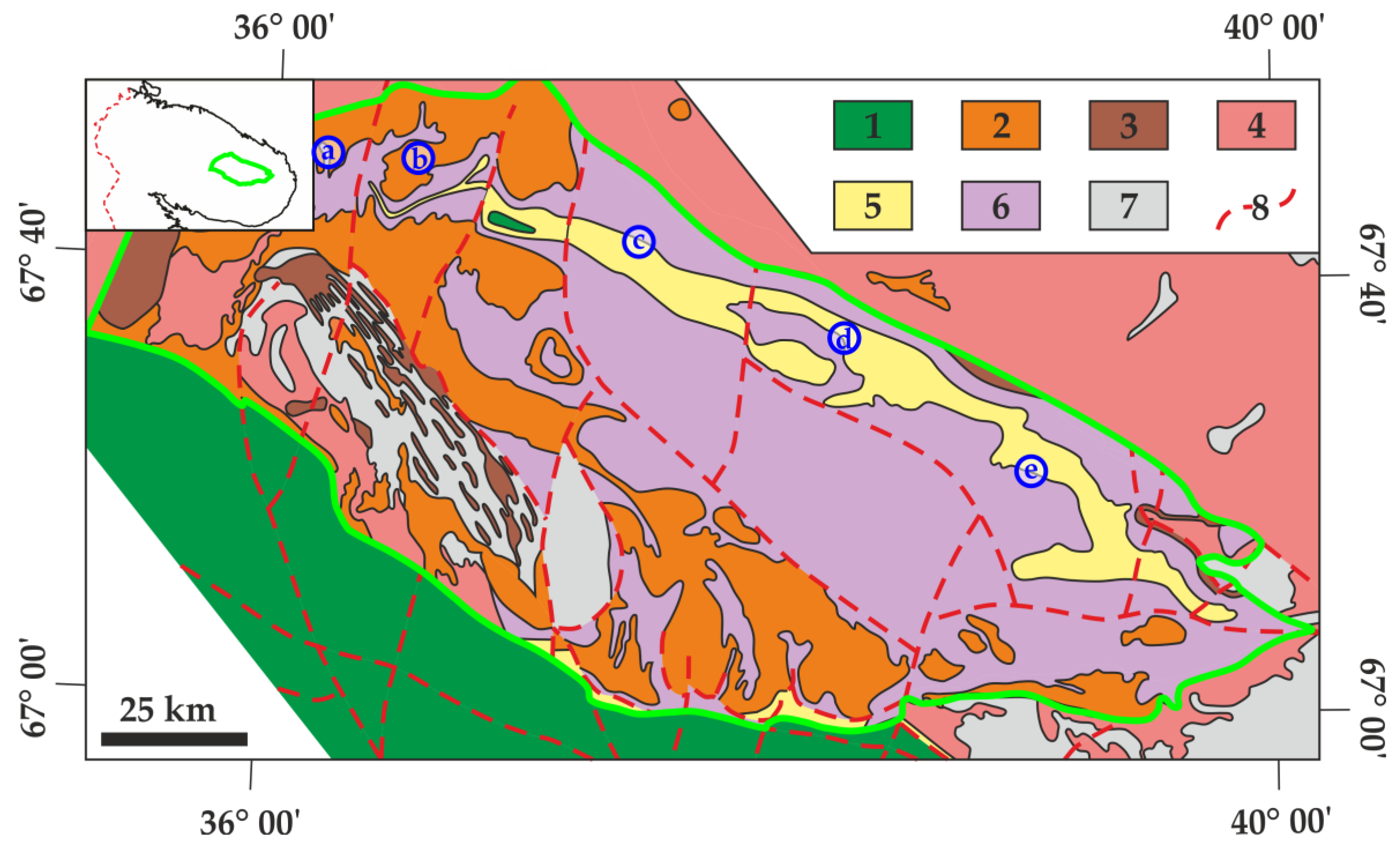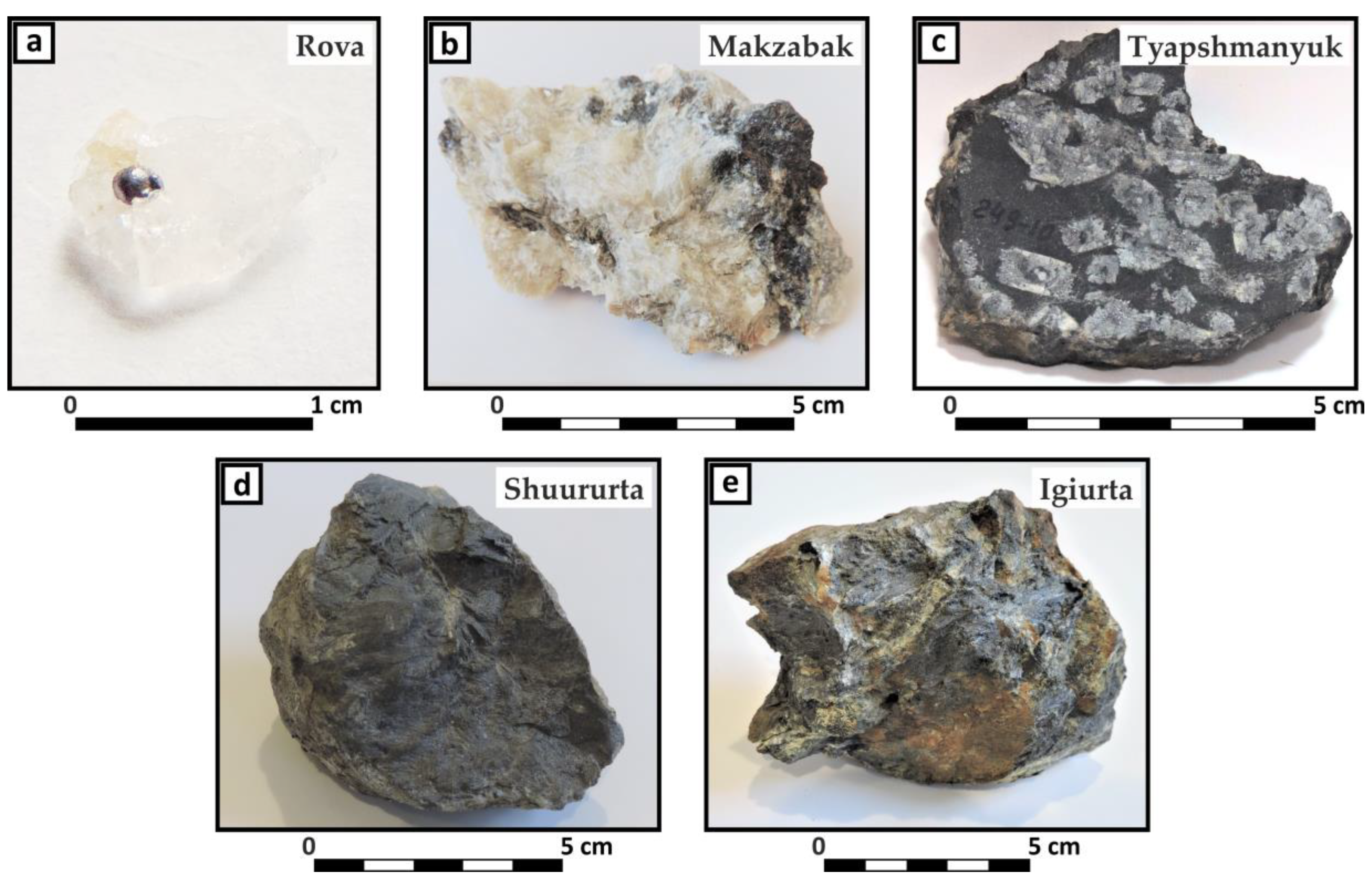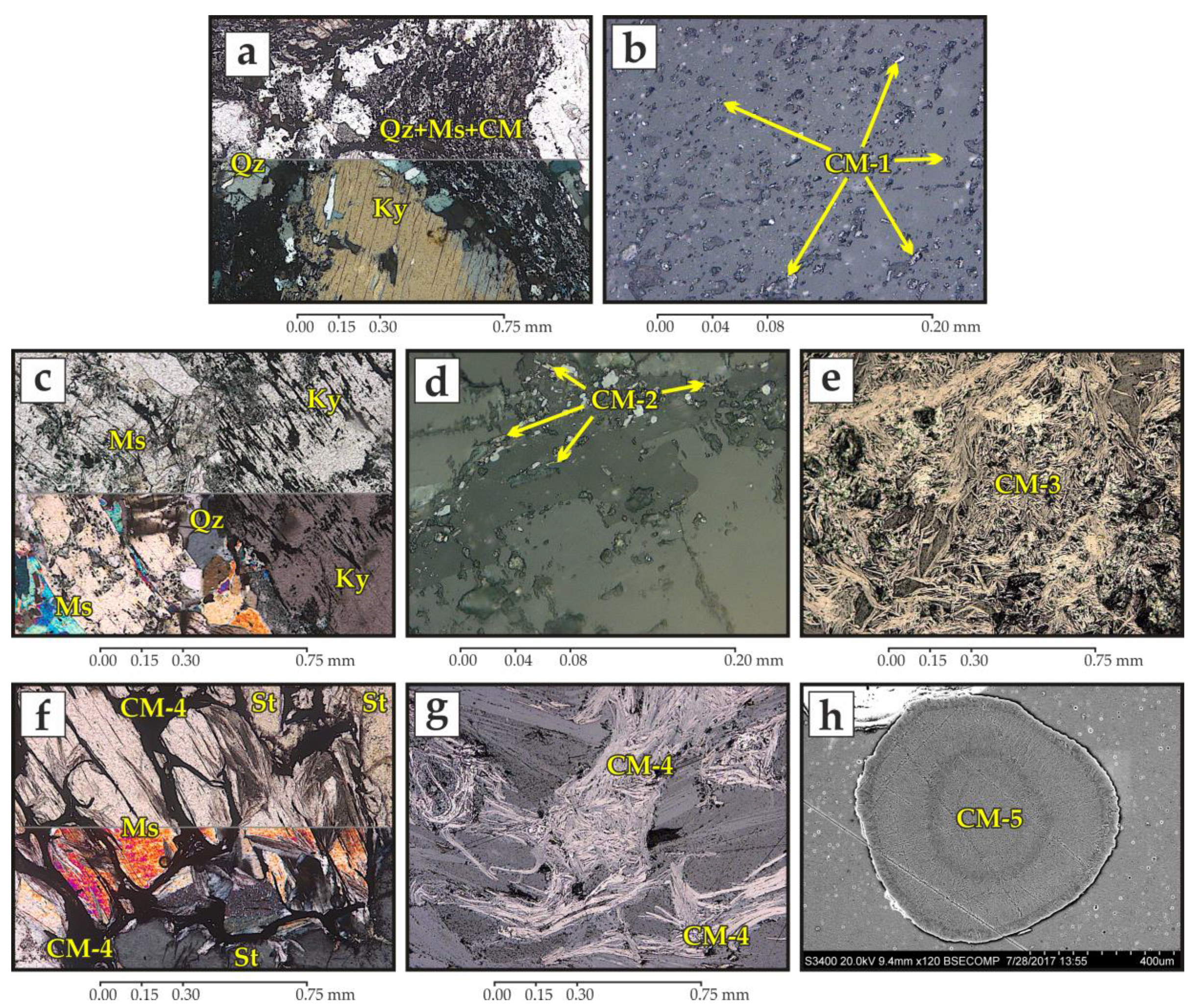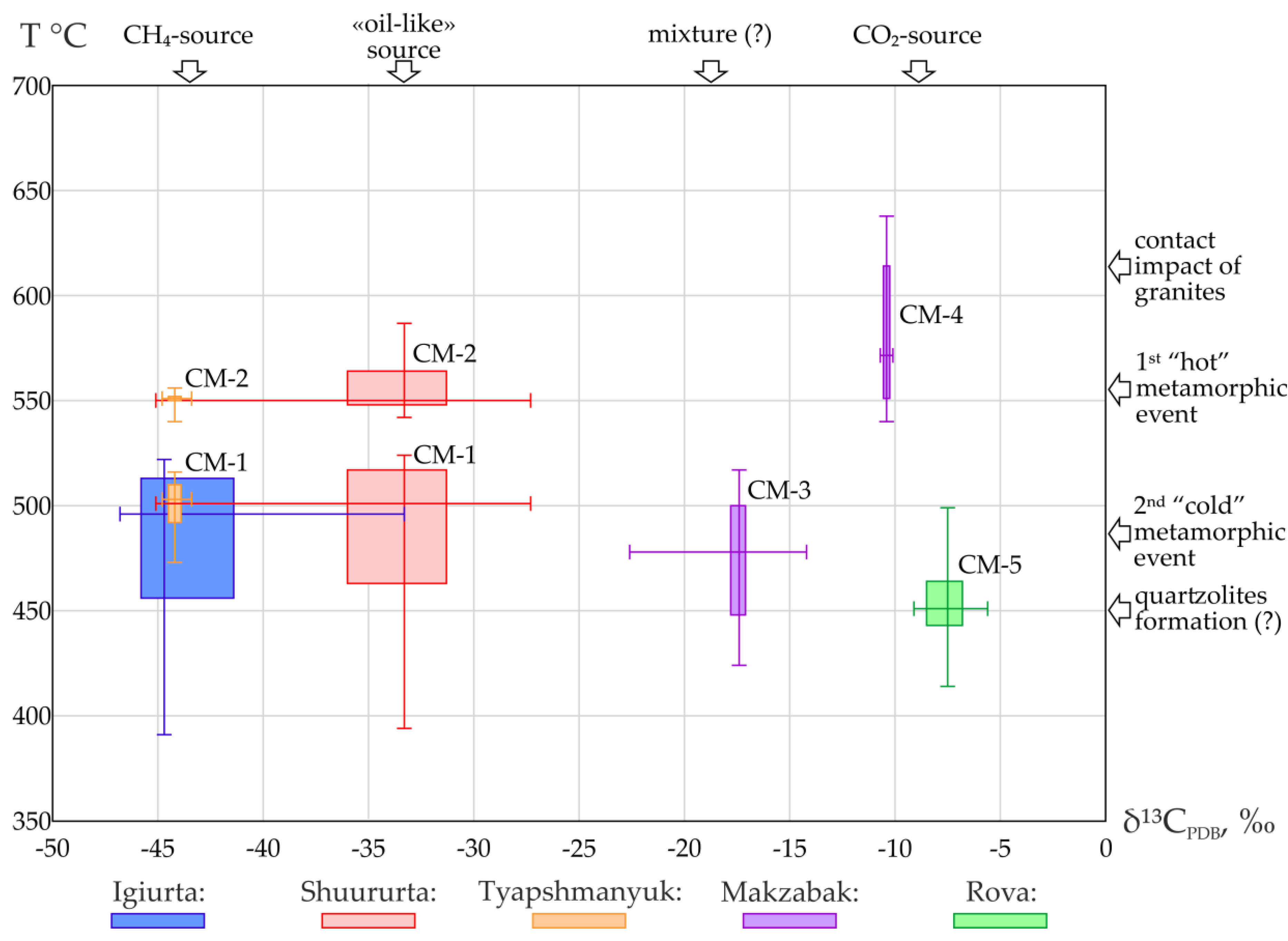Carbon Sources and the Graphitization of Carbonaceous Matter in Precambrian Rocks of the Keivy Terrane (Kola Peninsula, Russia)
Abstract
:1. Introduction
2. Materials and Methods
2.1. Samples
2.2. Analytical Methods
2.3. Raman Spectra Processing
3. Results
3.1. Morphology of Carbonaceous Matter
3.2. Stable Carbon Isotope Data
3.3. RSCM Temperature Estimates
- From 470 to 520 °C, with a mean value of 500 °C, for the samples of Tyapshmanyuk mountain;
- From 390 to 530 °C, with a mean value of 480°C, for the Shuururta mountain samples;
- From 390 to 520 °C, with a mean value of 480 °C, for the samples from the Igiurta mountain.
4. Discussion
5. Conclusions
- The extremely light (δ13CPDB = –40.2‰ to −46.8‰) carbonaceous matter characterizes the rocks from the northwest to the east of the Keivy Terrane.
- In the kyanite schists of the Shuururta mountain and the Igiurta mountain, along with extremely isotopically light CM, that with a carbon isotope composition of about –33‰ δ13CPDB is widespread. This denotes the existence of an additional carbon reservoir.
- Within the Keivy Terrane, CM with isotopically heavy carbon (δ13CPDB = −5.6‰ to −10.7‰) occurs both in quartzolites from alkaline granites, and in the sillimanite, schists surrounding the latter.
- CM graphitization in kyanite schists most likely occurred in two stages of regional metamorphism, the peak event and the regressive event, respectively. Peak temperatures of the CM graphitized are maximal in sillimanite schists surrounding alkaline granites in the northwest of the Keivy Terrane (> 580 °C). Those in the kyanite schists from the central part of the Terrane are lower (~ 550 °C). In CM from the east of the Keivy Terrane, no evidence of this peak metamorphic event was found. The mineral associations of the sillimanite and kyanite rocks, corresponding to amphibolite facies, reflect this early hot event. The obtained data suggest a relationship between this event and the regional heating induced by the intrusion of alkaline granite magmas in the Archaean period.
Author Contributions
Funding
Acknowledgments
Conflicts of Interest
References
- Sidorenko, S.A.; Sidorenko, A.V. Organic Matter in the Precambrian Sedimentary-Metamorphic Rocks; Nauka: Moskow, Russia, 1975. (In Russian) [Google Scholar]
- Melezhik, V.A.; Basalayev, A.A.; Predovskiy, A.A.; Balabonin, N.L.; Bolotov, V.I.; Pavlova, M.A.; Gavrilenko, B.V.; Abzalov, M.Z. Carbon Deposits of the Early Stages of the Earth’s Development (Geochemistry and Accumulation Conditions on the Baltic Shield); Zhukov, R.A., Ed.; Nauka: Leningrad, Russia, 1988. (In Russian) [Google Scholar]
- Bel’kov, I.V. Kyanite Schists of the Keivy Suite; Tochilin, M.S., Ed.; Academy of Sciences USSR: Leningrad, Russia, 1963. (In Russian) [Google Scholar]
- Petrov, V.P.; Belyaev, O.A.; Voloshina, Z.M.; Bogdanova, M.N.; Ivliyev, A.I. Metamorphism of Early Precambrian Supracrustal Complexes; Zagorodniy, V.G., Ed.; Nauka: Leningrad, Russia, 1986. (In Russian) [Google Scholar]
- Petrov, V.P.; Belyaev, O.A.; Voloshina, Z.M.; Balagansky, V.V.; Glazunkov, A.N.; Pozhilenko, V.I. Endogenous Metamorphic Regimes of the Early Precambrian (Northeastern Part of the Baltic Shield); Mitrofanov, F.P., Ed.; Nauka: Leningrad, Russia, 1990. (In Russian) [Google Scholar]
- Early Precambrian of the Baltic Shield; Glebovitskii, V.A. (Ed.) Nauka: St.-Petersburg, Russia, 2005. (In Russian) [Google Scholar]
- Pindyurina, E.O.; Kol’tsov, A.B. Schists of Keiv metamorphic complex (Kola Peninsula): Mineral paragenesis and formation conditions. Vestn. Spbsu 2015, 7, 38–58, (In Russian with English Abs.). [Google Scholar]
- Pushkarev, Y.D. Megacycles in the Evolution of the Crust–Mantle System; Nauka: Leningrad, Russia, 1990. (In Russian) [Google Scholar]
- Radchenko, A.T.; Balaganskiy, V.V.; Basalaev, A.A.; Vinogradov, A.N.; Golionko, G.B.; Petrov, V.P.; Pozhilenko, V.I.; Radchenko, M.K. Precambrian Tectonics of the Northeastern Part of the Baltic Shield (Explanatory Note for the 1:500,000 Geological Map); Mitrofanov, F.P., Ed.; Nauka: St.-Petersburg, Russia, 1992. (In Russian) [Google Scholar]
- Bushmin, S.A.; Glebovitskii, V.A.; Presnyakov, S.L.; Savva, E.V.; Shcheglova, T.P. New data on the age (SHRIMP II) of protolith and paleoproterozoic transformations of the Archean Keivy terrain (Kola Peninsula). Dokl. Earth Sci. 2011, 438, 661–665. [Google Scholar] [CrossRef]
- Mints, M.V. 3. Neoarchean intracontinental areas of sedimentation, magmatism, and high-temperature metamorphism (hot regions) in eastern Fennoscandia. In East European Craton: Early Precambrian History and 3D Models of Deep Crustal Structure; Mints, M.V., Konilov, A.N., Philippova, I.B., Zlobin, V.L., Babayants, P.S., Belousova, E.A., Blokh, Y.I., Bogina, M.M., Bush, W.A., Dokukin, P.A., et al., Eds.; Geological Society of America: Boulder, CO, USA, 2015; Volume 510, ISBN 9780813725109. [Google Scholar]
- Fallick, A.E.; Hanski, E.J.; Kump, L.R.; Medvedev, P.V.; Melezhik, V.A.; Prave, A.R.; Svetov, S.A. The Palaeoproterozoic of Fennoscandia as context for the Fennoscandian Arctic Russia—Drilling Early Earth Project. In The Early Palaeoproterozoic of Fennoscandia: Geological and Tectonic Settings // Reading the Archive of Earth’s Oxygenation; Melezhik, V.A., Ed.; Springer: Berlin/Heidelberg, Germany, 2013; pp. 33–38. ISBN 9783540885573. [Google Scholar]
- Balaganskiy, V.V.; Basalayev, A.A.; Belyaev, O.A.; Pozhilenko, V.I.; Radchenko, A.T.; Radchenko, M.K. The 1:500,000 Geological Map of the Kola Region (Northeastern Baltic Shield); Mitrofanov, F.P., Ed.; GI KSC RAS: Apatity, Russia, 1996. (In Russian) [Google Scholar]
- Mitrofanov, F.P.; Zozulya, D.R.; Bayanova, T.B.; Levkovich, N.V. The world’s oldest anorogenic alkali granitic magmatism in the Keivy structure on the Baltic Shield. Dokl. Earth Sci. 2000, 374, 238–241. [Google Scholar]
- Zozulya, D.R.; Bayanova, T.B.; Eby, G.N. Geology and Age of the Late Archean Keivy Alkaline Province, Northeastern Baltic Shield. J. Geol. 2005, 113, 601–608. [Google Scholar] [CrossRef]
- Vetrin, V.R.; Rodionov, N.V. Geology and geochronology of neoarchean anorogenic magmatism of the Keivy structure, Kola Peninsula. Petrology 2009, 17, 537–557. [Google Scholar] [CrossRef]
- Batieva, I.D. Petrology of Alkaline Granites in Kola Peninsula; Nauka: Leningrad, Russia, 1976. (In Russian) [Google Scholar]
- Balagansky, V.V.; Myskova, T.A.; Skublov, S.G. On the age of felsic metavolcanites of the Archaean Lebyazhka sequence, Kola region, Baltic Shield. In Proceedings of the Geology and Geochronology of the Rock-Forming and Ore Processes in Crystalline Shields, Apatity, Russia, 8–12 July 2013; Mitrofanov, F.P., Bayanova, T.B., Eds.; K&M Publishing House: Apatity, Russia, 2013; pp. 17–20. (In Russian). [Google Scholar]
- Bagiński, B.; Zozulya, D.; MacDonald, R.; Kartashov, P.M.; Dzierżanowski, P. Low-temperature hydrothermal alteration of a rare-metal rich quartz–epidote metasomatite from the El’ozero deposit, Kola Peninsula, Russia. Eur. J. Mineral. 2016, 28, 789–810. [Google Scholar] [CrossRef]
- Lyalina, L.M.; Zozulya, D.R.; Savchenko, Y.E.; Tarasov, M.P.; Selivanova, E.A.; Tarasova, E. Fluorbritholite-(Y) and yttrialite-(Y) from silexites of the Keivy alkali granites, Kola Peninsula. Geol. Ore Depos. 2014, 56, 589–602. [Google Scholar] [CrossRef]
- Macdonald, R.; Bagiński, B.; Zozulya, D. Differing responses of zircon, chevkinite-(Ce), monazite-(Ce) and fergusonite-(Y) to hydrothermal alteration: Evidence from the Keivy alkaline province, Kola Peninsula, Russia. Mineral. Petrol. 2017, 111, 523–545. [Google Scholar] [CrossRef]
- Bel’kov, I.V.; Batieva, I.D.; Vinogradova, G.V.; Vinogradov, A.N. Mineralization and Fluid Regime in the Contact Zones of Alkali Granite Intrusions; Petrov, V.P., Ed.; Academy of Sciences USSR: Apatity, Russia, 1988. (In Russian) [Google Scholar]
- Bayanova, T.B. Age of Reference Geological Complexes of the Kola Peninsula and Duration of the Magmatic Processes; Nauka: St.-Petersburg, Russia, 2004. (In Russian) [Google Scholar]
- Grew, E.S. Carbonaceous Material in Some Metamorphic Rocks of New England and Other Areas. J. Geol. 1974, 82, 50–73. [Google Scholar] [CrossRef]
- Buseck, P.R.; Beyssac, O. From Organic Matter to Graphite: Graphitization. Elements 2014, 10, 421–426. [Google Scholar] [CrossRef]
- Beyssac, O.; Goffé, B.; Chopin, C.; Rouzaud, J.N. Raman spectra of carbonaceous material in metasediments: A new geothermometer. J. Metamorph. Geol. 2002, 20, 859–871. [Google Scholar] [CrossRef]
- Aoya, M.; Kouketsu, Y.; Endo, S.; Shimizu, H.; Mizukami, T.; Nakamura, D.; Wallis, S. Extending the applicability of the Raman carbonaceous-material geothermometer using data from contact metamorphic rocks. J. Metamorph. Geol. 2010, 28, 895–914. [Google Scholar] [CrossRef]
- Lahfid, A.; Beyssac, O.; Deville, E.; Negro, F.; Chopin, C.; Goffé, B. Evolution of the Raman spectrum of carbonaceous material in low-grade metasediments of the Glarus Alps (Switzerland). Terra Nova 2010, 22, 354–360. [Google Scholar] [CrossRef]
- Rahl, J.; Anderson, K.; Brandon, M.; Fassoulas, C. Raman spectroscopic carbonaceous material thermometry of low-grade metamorphic rocks: Calibration and application to tectonic exhumation in Crete, Greece. Earth Planet. Sci. Lett. 2005, 240, 339–354. [Google Scholar] [CrossRef]
- Negro, F.; Beyssac, O.; Goffé, B.; Saddiqi, O.; Bouybaouene, M.L. Thermal structure of the Alboran Domain in the Rif (northern Morocco) and the Western Betics (southern Spain). Constraints from Raman spectroscopy of carbonaceous material. J. Metamorph. Geol. 2006, 24, 309–327. [Google Scholar] [CrossRef] [Green Version]
- Wyhlidal, S.; Tropper, P.; Thöny, W.F.; Kaindl, R. Minor element- and carbonaceous material thermometry of high-grade metapelites from the Sauwald Zone, Southern Bohemian Massif (Upper Austria). Mineral. Petrol. 2009, 97, 61–74. [Google Scholar] [CrossRef]
- Robert, A.; Pubellier, M.; de Sigoyer, J.; Vergne, J.; Lahfid, A.; Cattin, R.; Findling, N.; Zhu, J. Structural and thermal characters of the Longmen Shan (Sichuan, China). Tectonophysics 2010, 491, 165–173. [Google Scholar] [CrossRef]
- Hilchie, L.J.; Jamieson, R.A. Graphite thermometry in a low-pressure contact aureole, Halifax, Nova Scotia. Lithos 2014, 208–209, 21–33. [Google Scholar] [CrossRef]
- Long, S.P.; Gordon, S.M.; Young, J.P.; Soignard, E. Temperature and strain gradients through Lesser Himalayan rocks and across the Main Central thrust, south central Bhutan: Implications for transport-parallel stretching and inverted metamorphism. Tectonics 2016, 35, 1863–1891. [Google Scholar] [CrossRef]
- Safonov, O.G.; Reutsky, V.N.; Varlamov, D.A.; Yapaskurt, V.O.; Golunova, M.A.; Shcherbakov, V.D.; van Reenen, D.D.; Smit, A.C.; Butvina, V.G. Composition and source of fluids in high-temperature graphite-bearing granitoids associated with granulites: Examples from the Southern Marginal Zone, Limpopo Complex, South Africa. Gondwana Res. 2018, 60, 129–152. [Google Scholar] [CrossRef]
- Delchini, S.; Lahfid, A.; Plunder, A.; Michard, A. Applicability of the RSCM geothermometry approach in a complex tectono-metamorphic context: The Jebilet massif case study (Variscan Belt, Morocco). Lithos 2016, 256–257, 1–12. [Google Scholar] [CrossRef]
- Luque, F.J.; Pasteris, J.D.; Wopenka, B.; Rodas, M.; Barrenechea, J.F. Natural fluid-deposited graphite: Mineralogical characteristics and mechanisms of formation. Am. J. Sci. 1998, 298, 471–498. [Google Scholar] [CrossRef]
- Galvez, M.E.; Beyssac, O.; Martinez, I.; Benzerara, K.; Chaduteau, C.; Malvoisin, B.; Malavieille, J. Graphite formation by carbonate reduction during subduction. Nat. Geosci. 2013, 6, 473–477. [Google Scholar] [CrossRef]
- Galimov, E.M. Isotope organic geochemistry. Org. Geochem. 2006, 37, 1200–1262. [Google Scholar] [CrossRef]
- Reutsky, V.N.; Borzdov, Y.M.; Palyanov, Y.N. Effect of diamond growth rate on carbon isotope fractionation in Fe–Ni–C system. Diam. Relat. Mater. 2012, 21, 7–10. [Google Scholar] [CrossRef]
- Wopenka, B.; Pasteris, J.D. Structural characterization of kerogens to granulite-facies graphite: Applicability of Raman microprobe spectroscopy. Am. Mineral. 1993, 78, 533–557. [Google Scholar]
- Pasteris, J.D. In Situ Analysis in Geological Thin-Sections by Laser Raman Microprobe Spectroscopy: A Cautionary Note. Appl. Spectrosc. 1989, 43, 567–570. [Google Scholar] [CrossRef]
- Beyssac, O.; Goffé, B.; Petitet, J.-P.; Froigneux, E.; Moreau, M.; Rouzaud, J.-N. On the characterization of disordered and heterogeneous carbonaceous materials by Raman spectroscopy. Spectrochim. Acta Part A Mol. Biomol. Spectrosc. 2003, 59, 2267–2276. [Google Scholar] [CrossRef]
- Lünsdorf, N.K. Raman spectroscopy of dispersed vitrinite—Methodical aspects and correlation with reflectance. Int. J. Coal Geol. 2016, 153, 75–86. [Google Scholar] [CrossRef]
- Tuinstra, F.; Koenig, J.L. Raman Spectrum of Graphite. J. Chem. Phys. 1970, 53, 1126–1130. [Google Scholar] [CrossRef]
- Jaszczak, J.A.; Robinson, G.W.; Dimovski, S.; Gogotsi, Y. Naturally occurring graphite cones. Carbon 2003, 41, 2085–2092. [Google Scholar] [CrossRef]
- Duke, E.F.; Rumble, D. Textural and isotopic variations in graphite from plutonic rocks, South-Central New Hampshire. Contrib. Mineral. Petrol. 1986, 93, 409–419. [Google Scholar] [CrossRef]
- Barrenechea, J.F.; Luque, F.J.; Millward, D.; Ortega, L.; Beyssac, O.; Rodas, M. Graphite morphologies from the Borrowdale deposit (NW England, UK): Raman and SIMS data. Contrib. Mineral. Petrol. 2009, 158, 37–51. [Google Scholar] [CrossRef] [Green Version]
- Doroshkevich, A.G.; Wall, F.; Ripp, G.S. Magmatic graphite in dolomite carbonatite at Pogranichnoe, North Transbaikalia, Russia. Contrib. Mineral. Petrol. 2007, 153, 339–353. [Google Scholar] [CrossRef]
- Rantitsch, G.; Lämmerer, W.; Fisslthaler, E.; Mitsche, S.; Kaltenböck, H. On the discrimination of semi-graphite and graphite by Raman spectroscopy. Int. J. Coal Geol. 2016, 159, 48–56. [Google Scholar] [CrossRef]
- Ammar, M.R.; Rouzaud, J.-N. How to obtain a reliable structural characterization of polished graphitized carbons by Raman microspectroscopy. J. Raman Spectrosc. 2012, 43, 207–211. [Google Scholar] [CrossRef]
- Luque, F.J.; Huizenga, J.-M.; Crespo-Feo, E.; Wada, H.; Ortega, L.; Barrenechea, J.F. Vein graphite deposits: Geological settings, origin, and economic significance. Miner. Depos. 2014, 49, 261–277. [Google Scholar] [CrossRef]
- Crespo, E.; Luque, F.J.; Barrenechea, J.F.; Rodas, M. Influence of grinding on graphite crystallinity from experimental and natural data: Implications for graphite thermometry and sample preparation. Mineral. Mag. 2006, 70, 697–707. [Google Scholar] [CrossRef]
- Sheskin, D. Handbook of Parametric and Nonparametric Statistical Procedures; Chapman and Hall/CRC: New York, NY, USA, 2003; ISBN 978-1-58488-440-8. [Google Scholar]
- Gibbons, J.; Chakraborti, S. Nonparametric Statistical Inference. Fourth Edition, Revised and Expanded; Marcel Dekker: New York, NY, USA, 2003; ISBN 0-8247-4052-1. [Google Scholar]
- Hollander, M.; Wolfe, D.A. Nonparametric Statistical Methods. Second Edition; John Wiley & Sons: New York, NY, USA, 1999; ISBN 0-471-19045-4. [Google Scholar]
- Sprent, P.; Smeeton, N.C.; Smeeton, N.C. Applied Nonparametric Statistical Methods, Fourth Edition; Chapman and Hall/CRC: New York, NY, USA, 2016; ISBN 9781439894019. [Google Scholar]
- Bushmin, S.A.; Glebovitskii, V.A.; Prasolov, E.M.; Lokhov, K.I.; Vapnik, E.A.; Savva, E.V.; Shcheglova, T.P. Origin and composition of fluid responsible for metasomatic processes in shear zones of the Bolshie Keivy tectonic nappe, baltic shield: Carbon isotope composition of graphite. Dokl. Earth Sci. 2011, 438, 701–704. [Google Scholar] [CrossRef]
- Sherwood Lollar, B.; Westgate, T.D.; Ward, J.A.; Slater, G.F.; Lacrampe-Couloume, G. Abiogenic formation of alkanes in the Earth’s crust as a minor source for global hydrocarbon reservoirs. Nature 2002, 416, 522–524. [Google Scholar] [CrossRef]
- Lollar, B.S.; Lacrampe-Couloume, G.; Voglesonger, K.; Onstott, T.C.; Pratt, L.M.; Slater, G.F. Isotopic signatures of CH4 and higher hydrocarbon gases from Precambrian Shield sites: A model for abiogenic polymerization of hydrocarbons. Geochim. Cosmochim. Acta 2008, 72, 4778–4795. [Google Scholar] [CrossRef]
- Sherwood Lollar, B.; Frape, S.K.; Weise, S.M.; Fritz, P.; Macko, S.A.; Welhan, J.A. Abiogenic methanogenesis in crystalline rocks. Geochim. Cosmochim. Acta 1993, 57, 5087–5097. [Google Scholar] [CrossRef]
- Sherwood, B.; Fritz, P.; Frape, S.K.; Macko, S.A.; Weise, S.M.; Welhan, J.A. Methane occurrences in the Canadian Shield. Chem. Geol. 1988, 71, 223–236. [Google Scholar] [CrossRef]
- Stahl, W. Carbon isotope fractionations in natural gases. Nature 1974, 251, 134–135. [Google Scholar] [CrossRef]
- Ni, Y.; Dai, J. Geochemical characteristics of abiogenic alkane gases. Pet. Sci. 2009, 6, 327–338. [Google Scholar] [CrossRef]
- Cai, C.; Zhang, C.; Worden, R.H.; Wang, T.; Li, H.; Jiang, L.; Huang, S.; Zhang, B. Application of sulfur and carbon isotopes to oil–source rock correlation: A case study from the Tazhong area, Tarim Basin, China. Org. Geochem. 2015, 83–84, 140–152. [Google Scholar] [CrossRef]
- Shen, P.; Xu, Y.C. A study of carbon isotopes from oils. Chin. Sci. Bull. 1998, 43, 117. [Google Scholar] [CrossRef]
- Astafieva, M.M.; Balaganskii, V.V. Keivy Paraschists (Archean–Early Proterozoic): Nanobacteria and Life. Stratigr. Geol. Correl. 2018, 26, 354–363. [Google Scholar] [CrossRef]
- Kozlov, N.E.; Sorokhtin, N.O.; Martynov, E.V. Geodynamic Evolution and Metallogeny of Archaean Structural and Compositional Complexes in the Northwestern Russian Arctic. Minerals 2018, 8, 573. [Google Scholar] [CrossRef]
- Luque, F.J.; Crespo-Feo, E.; Barrenechea, J.F.; Ortega, L. Carbon isotopes of graphite: Implications on fluid history. Geosci. Front. 2012, 3, 197–207. [Google Scholar] [CrossRef] [Green Version]
- Santosh, M.; Wada, H. A Carbon Isotope Study of Graphites from the Kerala Khondalite Belt, Southern India: Evidence for CO2 Infiltration in Granulites. J. Geol. 1993, 101, 643–651. [Google Scholar] [CrossRef]
- Baiju, K.R.; Nambiar, C.G.; Jadhav, G.N.; Kagi, H.; Satish-Kumar, M. Low-density CO2-rich fluid inclusions from charnockites of southwestern Madurai Granulite Block, southern India; implications on graphite mineralization. J. Asian Earth Sci. 2009, 36, 332–340. [Google Scholar] [CrossRef]





| Sample | Locality | Long. (N) | Lat. (E) | Host Rock 1 | CM Type | n2 | δ13CPDB, ‰ |
|---|---|---|---|---|---|---|---|
| K-162 | Igiurta | 67.36658 | 39.02185 | Ky | CM-1 | 2 | −33.3…−38.2 |
| K-163 | Igiurta | 67.36794 | 39.02407 | Ky | CM-1 | 4 | −41.3…−45.8 |
| K-164 | Igiurta | 67.36933 | 39.02696 | Ky | CM-1 | 3 | −41.4…−45.9 |
| K-165 | Igiurta | 67.37166 | 39.03104 | Ky | CM-1 | 3 | −45.2…−46.8 |
| Igiurta, kyanite schists, only CM-1, n = 12: Median −44.7‰, mean −43.1‰, SD 4.0‰ | |||||||
| 249-10 | Tyapshmanyuk 3 | 67.72212 | 37.43463 | Ky | CM-1 + CM-2 | 4 | −43.4…−44.5 |
| 250-10 | Tyapshmanyuk 3 | 67.72084 | 37.43778 | Ky | CM-1 + CM-2 | 4 | −43.7…−44.8 |
| Tyapshmanyuk, kyanite schists, CM-1 + СM-2 mix, n = 8: Median −44.2‰, mean −44.2‰, SD 0.5‰ | |||||||
| K-197 | Shuururta | 67.58354 | 38.21614 | Ky | CM-1 + CM-2 | 2 | −29.1…−36.1 |
| K-200 | Shuururta | 67.58362 | 38.22089 | Ky | CM-1 + CM-2 | 2 | −41.3…−45.1 |
| K-201 | Shuururta | 67.58420 | 38.22161 | Ky | CM-1 + CM-2 | 4 | −27.3…−33.1 |
| K-202 | Shuururta | 67.58534 | 38.22317 | Ky | CM-1 + CM-2 | 3 | −30.1…−33.4 |
| K-203 | Shuururta | 67.58634 | 38.22675 | Ky | CM-1 + CM-2 | 2 | −35.2…−35.7 |
| K-216 | Shuururta | 67.59379 | 38.28372 | Ky | CM-1 + CM-2 | 3 | −30.9…−38.3 |
| G2-14-2 | Shuururta | 67.53086 | 38.09548 | Ky | CM-1 + CM-2 | 1 | −37.7 |
| G3-17-1 | Shuururta | 67.58487 | 38.22785 | Ky | CM-1 + CM-2 | 1 | −32.6 |
| G3-17-2 | Shuururta | 67.58487 | 38.22785 | Ky | CM-1 + CM-2 | 1 | −33.2 |
| G3-18-1 | Shuururta | 67.54943 | 38.27469 | Ky | CM-1 + CM-2 | 1 | −40.2 |
| G3-21-1 | Shuururta | 67.55296 | 38.29061 | Ky | CM-1 + CM-2 | 1 | −37.8 |
| G4-30-1 | Shuururta | 67.56740 | 38.08735 | Ky | CM-1 + CM-2 | 1 | −33.2 |
| G4-31-1 | Shuururta | 67.56934 | 38.06529 | Ky | CM-1 + CM-2 | 1 | −34.5 |
| Shuururta, kyanite schists, CM-1 + СM-2 mix, n = 23: Median −33.4‰, mean −34.3‰, SD 4.4‰ | |||||||
| F13028 | Makzabak | 67.84095 | 36.17565 | Sill | CM-3 + CM-4 | 20 | −14.2…−22.6 |
| Makzabak, sillimanite schists, CM-3 + СM-4 mix, n = 20: Median −17.4‰, mean −18.3‰, SD 1.7‰ | |||||||
| F13028 | Makzabak | 67.84095 | 36.17565 | Sill | CM-4 | 2 | −10.1…−10.7 |
| Makzabak, sillimanite schists, only СM-4, n = 2: Median −10.4‰, mean −10.4‰, SD 0.4‰ | |||||||
| F12026 | Rova | 67.83838 | 36.54107 | Qz | CM-5 | 9 | −5.6…−9.1 |
| Rova, quartzolites, СM-5, n = 9: Median −7.5‰, mean −7.4‰, SD 1.9‰ | |||||||
| Locality | Host Rock | CM Type | n | FWHMG (SD) | R1 (SD) | R2 (SD) | T (SD) | T* [R1*] | FWHMG* Calc. |
|---|---|---|---|---|---|---|---|---|---|
| Igiurta | Ky | CM-1 | 18 | 18.6 (1.1) | 0.30 (0.17) | 0.36 (0.09) | 480 (42) | 522 [0.15] | 19.3 |
| Tyapshmanyuk | Ky | CM-1 | 10 | 22.3 (1.5) | 0.29 (0.04) | 0.32 (0.03) | 501 (14) | 510 [0.24] | 22.5 |
| Tyapshmanyuk | Ky | CM-2 | 6 | 20.7 (0.6) | 0.18 (0.03) | 0.21 (0.01) | 549 (5) | 552 [0.16] | 19.5 |
| Shuururta | Ky | CM-1 | 6 | 18.7 (2.0) | 0.34 (0.23) | 0.36 (0.12) | 482 (51) | 525 [0.17] | 20.0 |
| Shuururta | Ky | CM-2 | 8 | 17.1 (0.7) | 0.12 (0.03) | 0.19 (0.03) | 557 (15) | 564 [0.10] | 16.8 |
| Makzabak | Sill | CM-3 | 15 | 23.0 (1.2) | 0.44 (0.16) | 0.38 (0.07) | 472 (32) | 496 [0.23] | 21.9 |
| Makzabak | Sill | CM-4 | 7 | 20.3 (1.8) | 0.10 (0.07) | 0.13 (0.09) | 582 (42) | 636 [0.01] | 14.1 |
| Rova | Qz | CM-5 | 68 | 19.2 (1.7) | 0.43 (0.08) | 0.42 (0.04) | 454 (18) | 499 [0.25] | 22.6 |
© 2019 by the authors. Licensee MDPI, Basel, Switzerland. This article is an open access article distributed under the terms and conditions of the Creative Commons Attribution (CC BY) license (http://creativecommons.org/licenses/by/4.0/).
Share and Cite
Fomina, E.; Kozlov, E.; Lokhov, K.; Lokhova, O.; Bocharov, V. Carbon Sources and the Graphitization of Carbonaceous Matter in Precambrian Rocks of the Keivy Terrane (Kola Peninsula, Russia). Minerals 2019, 9, 94. https://doi.org/10.3390/min9020094
Fomina E, Kozlov E, Lokhov K, Lokhova O, Bocharov V. Carbon Sources and the Graphitization of Carbonaceous Matter in Precambrian Rocks of the Keivy Terrane (Kola Peninsula, Russia). Minerals. 2019; 9(2):94. https://doi.org/10.3390/min9020094
Chicago/Turabian StyleFomina, Ekaterina, Evgeniy Kozlov, Kirill Lokhov, Olga Lokhova, and Vladimir Bocharov. 2019. "Carbon Sources and the Graphitization of Carbonaceous Matter in Precambrian Rocks of the Keivy Terrane (Kola Peninsula, Russia)" Minerals 9, no. 2: 94. https://doi.org/10.3390/min9020094






